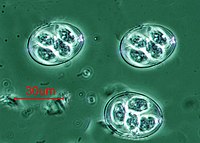Gene transcriptions/Elements/EIF4E basals
The EIF4E basal element, also eIF4E, (4EBE) is a basal promoter element for the eukaryotic translation initiation factor 4E. "Interactions between 4EBE and upstream activator sites are position, distance, and sequence dependent."[1]

Genetics
editGenetics involves the expression, transmission, and variation of inherited characteristics.
Eukaryote genes
editDef. "[a]ny of the single-celled or multicellular organisms whose cells contain at least one distinct nucleus"[2] is called a eukaryote.
Those specific genes that cause cells to contain at least one distinct nucleus are eukaryote genes.
Gene transcriptions
editDNA is a double helix of interlinked nucleotides surrounded by an epigenome. On the basis of biochemical signals, an enzyme, specifically a ribonucleic acid (RNA) polymerase, is chemically bonded to one of the strands (the template strand) of this double helix. The polymerase, once phosphorylated, begins to catalyze the formation of RNA using the template strand. Although the catalysis may have more than one beginning nucleotide (a start site) and more than one ending nucleotide (a stop site) along the DNA, each nucleotide sequence catalyzed that ultimately produces approximately the same RNA is part of a gene. The catalysis of each RNA representation from the template DNA is a transcription, specifically a gene transcription. The overall process is also referred to as gene transcription.
Basal elements
editCore promoters
editThe location of the 4EBE is at the site where the TATA box should be found.[1] At position -25 nucleotides upstream from the transcription start site, this basal promoter element for eIF4E named "4EBE" is sufficient to replace TATA sequences in a heterologous reporter construct."[1]
Eukaryotic translation initiation factor 4E
editThe "Eukaryotic translation initiation factor 4E, also known as eIF4E, is a protein that in humans is encoded by the EIF4E gene.[3][4]"[5]
Consensus sequences
editThe consensus sequence is 3'-TTACCCCCCCTT-5' in the direction of transcription.[1]
DNA-binding protein
edit"Specific DNA-binding proteins, including YY1, TFII-I, USF, and E2F, bind initiator elements" (Inr)s.[1]
Although 4EBE appears similar to an Inr, it is "not transactivated by YY1", does "not cross-compete with known initiator sequences", is "not supershifted by antibodies to any known initiator-binding proteins", and does "not bind SP1".[1]
Hypotheses
edit- A1BG is not transcribed by an eIF4E basal element.
Samplings
editThe EIF4E basal element, also eIF4E, (4EBE) is a basal promoter element for the eukaryotic translation initiation factor 4E. "Interactions between 4EBE and upstream activator sites are position, distance, and sequence dependent."[1]
The consensus sequence is 3'-TTACCCCCCCTT-5' in the direction of transcription.[1]
For the Basic programs (starting with Successables4EBE.bas) written to compare nucleotide sequences with the sequences on either the template strand (-), or coding strand (+), of the DNA, in the negative direction (-), or the positive direction (+), including extending the number of nts from 958 to 4445, the programs are, are looking for, and found:
- negative strand in the negative direction is Successables4EBE--.bas, looking for 3'-TTACCCCCCCTT-5', 0,
- negative strand in the positive direction is Successables4EBE-+.bas, looking for 3'-TTACCCCCCCTT-5', 0,
- positive strand in the negative direction is Successables4EBE+-.bas, looking for 3'-TTACCCCCCCTT-5', 0,
- positive strand in the positive direction is Successables4EBE++.bas, looking for 3'-TTACCCCCCCTT-5', 0,
- complement, negative strand, negative direction is Successables4EBEc--.bas, looking for 3'-AATGGGGGGGAA-5', 0,
- complement, negative strand, positive direction is Successables4EBEc-+.bas, looking for 3'-AATGGGGGGGAA-5', 0,
- complement, positive strand, negative direction is Successables4EBEc+-.bas, looking for 3'-AATGGGGGGGAA-5', 0,
- complement, positive strand, negative direction is Successables4EBEc++.bas, looking for 3'-AATGGGGGGGAA-5', 0,
- inverse complement, negative strand, negative direction is Successables4EBEci--.bas, looking for 3'-AAGGGGGGGTAA-5', 0,
- inverse complement, negative strand, positive direction is Successables4EBEci-+.bas, looking for 3'-AAGGGGGGGTAA-5', 0,
- inverse complement, positive strand, negative direction is Successables4EBEci+-.bas, looking for 3'-AAGGGGGGGTAA-5', 0,
- inverse complement, positive strand, positive direction is Successables4EBEci++.bas, looking for 3'-AAGGGGGGGTAA-5', 0,
- inverse, negative strand, negative direction, is Successables4EBEi--.bas, looking for 3'-TTCCCCCCCATT-5', 0,
- inverse, negative strand, positive direction, is Successables4EBEi--.bas, looking for 3'-TTCCCCCCCATT-5', 0,
- inverse, positive strand, negative direction, is Successables4EBEi+-.bas, looking for 3'-TTCCCCCCCATT-5', 0,
- inverse, positive strand, positive direction, is Successables4EBEi++.bas, looking for 3'-TTCCCCCCCATT-5', 0.
See also
editReferences
edit- ↑ 1.0 1.1 1.2 1.3 1.4 1.5 1.6 1.7 Mary Lynch, Li Chen, Michael J. Ravitz, Sapna Mehtani, Kevin Korenblat, Michael J. Pazin and Emmett V. Schmidt (August 2005). "hnRNP K Binds a Core Polypyrimidine Element in the Eukaryotic Translation Initiation Factor 4E (eIF4E) Promoter, and Its Regulation of eIF4E Contributes to Neoplastic Transformation". Molecular and Cellular Biology 25 (15): 6436-53. doi:10.1128/MCB.25.15.6436-6453.2005. http://mcb.asm.org/content/25/15/6436.full. Retrieved 2013-03-17.
- ↑ "eukaryote, In: Wiktionary". San Francisco, California: Wikimedia Foundation, Inc. October 16, 2012. Retrieved 2012-10-27.
- ↑ Pelletier J, Brook JD, Housman DE (August 1991). "Assignment of two of the translation initiation factor-4E (EIF4EL1 and EIF4EL2) genes to human chromosomes 4 and 20". Genomics 10 (4): 1079–82. doi:10.1016/0888-7543(91)90203-Q. PMID 1916814.
- ↑ Jones RM, MacDonald ME, Branda J, Altherr MR, Louis DN, Schmidt EV (May 1997). "Assignment of the human gene encoding eukaryotic initiation factor 4E (EIF4E) to the region q21-25 on chromosome 4". Somat. Cell Mol. Genet. 23 (3): 221–3. doi:10.1007/BF02721373. PMID 9330633.
- ↑ "EIF4E, In: Wikipedia". San Francisco, California: Wikimedia Foundation, Inc. March 17, 2013. Retrieved 2013-03-17.
Further reading
edit- Mary Lynch, Li Chen, Michael J. Ravitz, Sapna Mehtani, Kevin Korenblat, Michael J. Pazin and Emmett V. Schmidt (August 2005). "hnRNP K Binds a Core Polypyrimidine Element in the Eukaryotic Translation Initiation Factor 4E (eIF4E) Promoter, and Its Regulation of eIF4E Contributes to Neoplastic Transformation". Molecular and Cellular Biology 25 (15): 6436-53. doi:10.1128/MCB.25.15.6436-6453.2005. http://mcb.asm.org/content/25/15/6436.full. Retrieved 2013-03-17.
External links
edit- African Journals Online
- Bing Advanced search
- GenomeNet KEGG database
- Google Books
- Google scholar Advanced Scholar Search
- Home - Gene - NCBI
- JSTOR
- Lycos search
- NCBI All Databases Search
- NCBI Site Search
- Office of Scientific & Technical Information
- PubChem Public Chemical Database
- Questia - The Online Library of Books and Journals
- SAGE journals online
- Scirus for scientific information only advanced search
- SpringerLink
- Taylor & Francis Online
- WikiDoc The Living Textbook of Medicine
- Wiley Online Library Advanced Search
- Yahoo Advanced Web Search